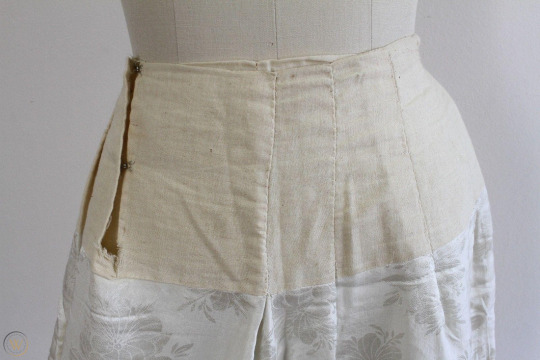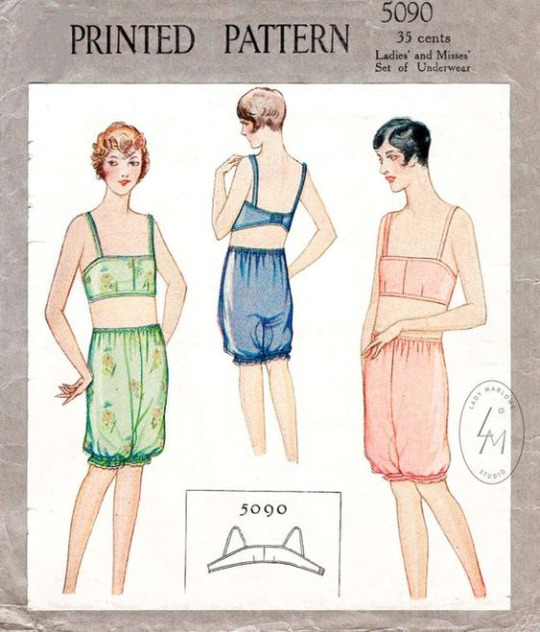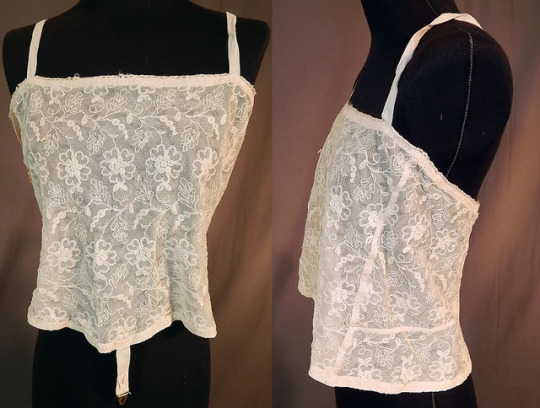#1910s antique camisole
Text

SofiasCobwebMuseum
#antique tatted crochet yoke#1910s antique camisole#antique corset cover#antique lingerie#1910s tatted camisole#1910s rose beige crochet yoke
10 notes
·
View notes
Photo

Camisole, 1915.
43 notes
·
View notes
Note
Hi Audrey, I love your blog it's so helpful! I hope you don't mind me asking, how were pants for men and women fastened (say in late 1920s)? I've seen Western knickers just after this time period using woven fabric and flat round (plastic?) buttons so wondered if there was a fly placket with buttons or a drawstring instead. It seems a bit early for elastic although I've seen crop bras advertised (in an English newspaper) with what looks like shirring elastic at this time. Thank you so much!
Hi, that's a great question! Thank you for asking, I haven't paid much attention to that before. I looked up some museum originals of women's pants (because they're more widely available) from the 19th and early 20th centuries and it seems like they were fastened with a separate fabric belt instead of any closures on the pants themselves. Fly plackets were generally not used for Chinese women’s pants.

Source here
Early republican era Han women's pants from the China Silk Museum. It’s really frustrating that they’re just labelled as “republican era” and no specific year/decade is given :/
Pants since the Qing Dynasty were usually constructed using two straight cut legs laid diagonally, connected by a triangular/concave gusset at the crotch and sewn to a straight, wide waistband. From all the period originals I've seen so far none of them feature drawstrings, buttons or any kind of closures. The structure wasn’t much different for men’s and women’s pants. I was only able to find out about the separate belt from one source so it may or may not be super credible. It’s from an article called “清代合裆女裤的造型特征与制作工艺” from 2016 written by 牛梨, 张文翰 and 崔荣荣 published in the 服装学报 Journal of Clothing Research.
穿时先将裤腰抿掖,然后用一条长带系结,余幅垂下为饰。
When wearing [these pants] the waistband is tucked together first, then tied using a long ribbon, the rest draping down as decoration.
Drawstrings could also be inserted into the waistband.

Source here
Pants from the V&A Museum, labelled 19th century. This doesn’t look very 19th century with the thin waistband and straight cut but blame the museum if the date isn’t correct :3
I found this other example of drawstring closure from what looks like a loungewear/pajama set. It looks 1920s but could be from any time in the republican era.


Source here
I scoured the internet for other pants closures and found this one pair of women’s pants from the 1920s which closes with hooks and eyes at a side opening. However since they’re from an antique shop the provenance is not clear and they may as well be Chinese-American and/or home made, not representing what was common in China at the time.


Source here
As to the closure with a placket and buttons you’ve mentioned, I did find a ca. 1910s mamian skirt that was constructed like that. I’m not sure if pants could be closed like as well.

Source here
Ca. 1910s mamian skirt with the front qunmen as a placket with buttons. From the China Silk Museum. Many Western skirts of the same time were closed like this as well, so this seems pretty plausible.
Elastic did exist in the 1920s but was used more often for underwear than outerwear I think. There were many camisoles and drawers with elasticated waists as well as corsets with elastic panels. Though I don’t think it would be appropriate to apply an elastic band to outer pants.

Source here
1920s sewing pattern for bloomers with elastic band at the waist and shirring elastic at the hems (from Lady Marlowe on Etsy).
By around the 1950s Western dress pants became the norm judging by what was included in sewing guide books of the time, so pants were fastened by a fly placket with zipper, button and/or hook and bar. Belts would also be worn so I guess we’ve come full circle.

Source here
1950s men’s pants.
The thing is, given the diversity of clothing construction in the republican era there should be many different, innovative closures for pants, especially pants made by home sewists. For some reason it’s incredibly difficult to find actual period examples of pants, museums are a lot more keen on collecting “dragon robes” (jifu robes), cheongsam and ceremonial qungua, maybe because they think they’re of more value and represent “old China” better. Why do I smell Orientalism...
#historic fashion#chinese fashion#qing dynasty#republican era#19th century#20th century#vintage fashion#vintage pants
129 notes
·
View notes
Link
2 notes
·
View notes
Photo

Camisole, 1915
36 notes
·
View notes